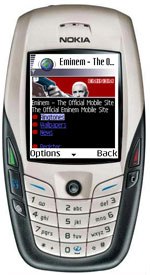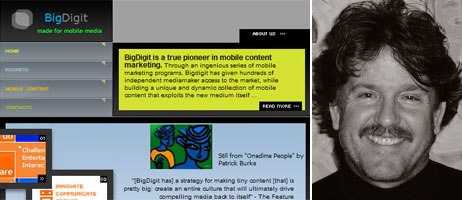Brands still dominate, but a growing number of opportunities exist for animators to sell their content for cell phone distribution. Karen Raugust reports.

High-profile brands dominate the emerging market for mobile entertainment particularly when it comes to streaming content and thats likely to continue for the foreseeable future. Yet there are many options for animators to license their content for viewing on mobile phones. The new Emmy category for mobile-only content is one indication the industry is taking cell phone entertainment seriously.
While wireless phones do not generate much in revenues for content providers yet, experts say now is the time to get involved. Its a great place for new animators to get their foot in the door, says Paula Montondo, president of BlipTV, a service offering short, mostly comedic live-action and animated entertainment on Sprint.
Animators see cell phones as a means to gain exposure for content produced at relatively low cost, while generating a small royalty stream. They see mobile as promising right now, says Dale Knoop, general manager of multimedia services at Sprint. Some are even starting to just produce for mobile, where theres an opportunity to get licensed and get paid.

[Mobile] is a matter of keen interest, reports Anil Malhotra, co-founder/vp of alliances and marketing at Bango, a direct-to-consumer mobile entertainment service. Bango has seen significant attendance from independent producers in the seminars it runs for the creative community; it plans to host additional seminars this spring in New York and L.A. But, Malhotra cautions, In terms of actual measurable revenues and downloads, the bigger brands with the bigger marketing budgets are seeing the lions share of transactions.
Brands wont ever be a difficult sale and will continue to dominate, agrees Beau Buck, ceo of Big Digit Inc., which operates mFlix, an independent mobile short film channel, and of Ultrashort Media, whose channels include Kult Kartoons. mFlix is available on Sprint in the U.S. and O2 in the U.K., as well as through third-party content publishers such as Jamster and Mobix Interactive. It shows about 2,000 films per day.
Most carriers and aggregators want to offer a mix of branded and original content. TV content is still really popular and very important for our subscribers, says Paul Scanlan, co-founder/coo of MobiTV, a streaming service available on carriers including Sprint, Cingular, Midwest Wireless and Alltel. But some of our most popular channels are those weve created specifically for mobile.
In addition to featuring branded channels such as Cartoon Network, YTV and Treehouse, MobiTV programs its own channels such as ToonWorld TV Classics, consisting of cartoons such as Gumby and Betty Boop; the Comedy Time Channel, produced in partnership with improv club owner Power Entertainment, showing clips of live stand-up comedy; and Max Sports, offering sports events filmed specifically for mobile. NBC Newss mobile channel, available on MobiTV, also creates content thats unique for the mobile environment. Its the same news but its filmed, edited and written for mobile, says Scanlan, who cites mobile-specific characteristics such as tighter shots, bigger areas for text and separate screens for graphics (as opposed to insets).
Scanlan points out that most people sign up for certain services or channels because of brands they recognize, but, once on board, they like to try out unfamiliar content within the same service. Once Im a subscriber, what I watch might be different than the channel that encouraged me to buy in the first place, he says.
Selling Original Animation
Mobile aggregators are increasingly on the lookout for original content, either exclusively or to supplement their branded offerings. In addition to the examples cited above, aggregators include In-Fusio, whose SmashTV service includes an animation channel, SmashToons, and which has forged deals with Vancouver Film School, ANS Animations, Speed Racer Enterprises and others, and Fun Little Movies, available on Sprint and SmartVideo, whose funny little phone films include a mix of live action and animation from creators such as Tamara Bick, Face2Face and Puppet Greetings.

Aggregators license content from various sources to create streaming channels, and/or a menu of downloadable entertainment, and sell to mobile phone carriers, such as Sprint or Verizon in the U.S. They split revenues with the providers; the latters shares for streaming content typically range from 20% to 50%. (Total revenues are not large; at mFlix, for example, the content providers share translates to about three to six cents per view.) The aggregators encode the material, distribute, market and sell it, collect revenues and pay out the royalties.
We cant pay huge amounts to animators at this point, confirms Dana Witt, business development manager for In-Fusio North America, which shares revenues 50/50. But if we do well, they do well.
While aggregators represent the best route for independent animators to sell their work for wireless distribution, some carriers are open to receiving submissions directly. In the U.S., only Sprint and Verizon have the technical set-up currently to offer streaming animation, but others such as T-Mobile and Cingular can offer downloads and are expected to move into streaming media in the future. Many international carriers also distribute entertainment content.

Most carriers supplement their branded offerings with some originals, including animation, most of which comes from leading aggregators. Sprint has been particularly enthusiastic about original shorts, offering SmashTV, Fun Little Movies, BlipTV, MobiTV and mFlix. Theyre very open to trying things and seeing what will work, says Montondo.
Were always looking for fresh content, explains Knoop of Sprint, which reviews submissions weekly. While the company most often acquires original content through aggregators, it welcomes submissions direct from content providers as well.
Another distribution option, more common in Europe than in the U.S. to date, is working with a Mobile Virtual Network Operator (MVNO), which provides the same services as a traditional carrierincluding voice, text and entertainment content but does not own its own spectrum or infrastructure. It buys minutes from traditional operators and sells them, with its own services, to its subscribers.

One example of an MVNO is Ampd Mobile, which is partnered with Verizon and targets 18 to 34-year-olds. Its entertainment service, launched this month, is called Ampd Live and features animated and live-action content. It claims to have the largest menu of mobile originals, which include six animated and scripted programs from Donick Cary, who has worked on The Simpsons. Weve made deals with College Humor.com and Break.com, which will be providing viral videos from people around the world, so you never know where youll find the next big hit, says Seth Cummings, svp, content and Internet services.
Ampd Live also offers branded channels incorporating video, wallpapers and ringtones from providers such as Cartoon Networks Adult Swim, MTV (including Beavis and Butt-Head content), and Warner Bros. (Looney Tunes and Hanna-Barbera).

Open Systems
While the typical mobile carrier operates a closed system similar to television, content providers must pitch their ideas to the carriers, which accept just a small percentage of what they see there are also open systems, more akin to the Internet model, where anyone can make content available for wireless users.
An example of the latter is Bango, which allows brand marketers, independent content creators and aggregators to post offerings that consumers can access from any cellular network, as long as they have the proper technical requirements (for example, a service and a handset capable of handling streaming animation). Providers cost is as little as $20 a month and theres no long-term contract. Its like eBay in a way, says Malhotra. Wal-Mart can sell its overstock through eBay, but I can sell an old CD on eBay as well.

Content available through Bangos direct-to-consumer service ranges from games and ringtones to streaming video and animation. Creators or other providers register with Bango, set their prices and post content on their own mobile Internet site. They receive an SMS short code that gives end-users access to their content, and can then promote the code in their marketing efforts to generate traffic. (Content providers are responsible for marketing to potential end-users.) They receive payment from Bango whenever someone purchases something from them. Bango has alliances with Cingular in the U.S. and Vodafone, Orange, Telefonica and O2 abroad, which enables customers of those services to choose Bango content and be invoiced for it on their phone bill. Users of any cellular network can access the content, however.
In addition to selling to an aggregator or carrier or posting content on an open system like Bango, other means for animators to secure wireless distribution for their original work include contests and branded sites. An example of the former is the ongoing mobilemediafest.com, where winners earn prizes such as a years distribution with Fun Little Movies. Meanwhile, more brands are including animation as part of their content mix, often licensed from third-party providers. This is the case for some of the providers distributing through Bango, according to Andrew Kerr, vp, North America, who cites Hearst Magazines Cosmo as one site that plans to offer relevant animation clips.
Content Specs
As is true of pitching to any distribution channel, animators must research the market and submit content that matches the channels sensibility. Fun Little Movies looks exclusively for G- and PG-rated humor, for instance, while mFlix is more edgy and provocative. Frank Chindamo, president and chief creative officer at Fun Little Movies, recommends looking at the companys website before pitching. It gives you an idea of the taste and flavor of the network, he says. Its amazing how many pitches dont fit our criteria.
One commonality among the various channels is that content has to be short, most often one to three minutes for streaming animation. Over two to three minutes, you start losing people, says Montondo of BlipTV, which has films as short as five seconds, with most in the 30 to 90 second range. For downloads, length is even shorter, usually 10 to 20 seconds.

What mobile is about, inherently, is brevity, stresses Knoop. When you text message youre not even using full words. He notes that creators need to strive for a balance between keeping their clips within the confines of what works in the mobile environment, while not surrendering creativity: Its tough to tell any story in less than 30 seconds.
Theres a big difference between how [consumers] watch TV on their cell phones and how they watch at home, Scanlan explains. On phones, viewers tend to watch frequently for short bursts. We call it TV snacking, Scanlan says, noting that, due to the unscheduled nature of the medium, clips need to be entertaining even if the viewer misses the beginning or end of a programming block. Stand-up comedy, music video and news are genres that work well in this environment; short, one-joke animation clips do too.
Limits of Technology
Animators also need to remember the technical limitations of the medium. A clean, Flash-animated style looks better than something with too many special effects, given the postage stamp-sized screen, and vivid colors look better than pastels. In addition, animators need to follow the guidelines for each service. For instance, Flash works well for producing clips, but they must be exported into another format for services such as mFlix, which requires AVI, MPEG or Quicktime files. Buck recommends previewing any content before submitting it, to make sure the audio is on the audio track and the video on the video track, for example.
While animators need to keep their creations simple, they should not forget about production values. Because there is minimal return on investment, many creators put very little money into their productions, and it shows. Theres a market for purely made-for-mobile content, but the production values arent there yet, says Scanlan. On the other hand, if the content is particularly entertaining or touching, a clip may make the cut anyway. We look for high production values and interest levels, but there are jewels out there that dont have the production values, and are really funny.

Some mobile markets, such as MobiTV or iFilm, buy primarily one-offs, while others prefer episodic series. Many consider both formats. The ideal for Fun Little Movies would be a series with at least 100 episodes. SmashTV, which used to license single films, now focuses on series, mainly due to time constraints; it takes just as long to negotiate for a series as for a single short film. Series tend to exhibit better financial potential for content providers as well, since more views are possible as people come back for additional episodes.
Knoop points out that a streaming mobile channel devoted to one property needs a lot of content. You cant have a standalone channel running in perpetuity on 70 episodes, he says. He points out that the company will often refer creators of content it likes to an aggregator if there are not enough episodes to sustain a dedicated channel. Some creators combine their own content with compatible clips from other artists to form a complete channel, in essence becoming aggregators themselves.
In the future, perhaps the near future, content may become more attractive if it can be linked to a sponsor. Chindamo says that day has already come, noting that a sponsor brings in money upfront to allow the creation of new episodes. Theres just not enough money in revenue-sharing yet to pay our costs or the animators costs, he says, adding that a direct-response advertiser promoting an 800-number, website URL or other call to action would be the ideal sponsor. Sponsorship is where production financing is going to be coming from in 2006, as far as I can see.
But Witt cautions that the bulk of carriers dont allow advertising messages yet, afraid they will drive consumers away. Animators can, however, provide a link to their own website at the end of a streaming clip, which allows them to promote their own work.
Global Outlook
Another attractive quality for original content is its ability to work globally, something that is particularly easy to do with animation. Chindamo points out there are about 1 million users of phones capable of receiving streaming animation in the U.S. today, versus an estimated 70 million in Japan, 7 million in India, 3 million in Australia and 200 million in China. Why play to a million when you can play to a billion? he asks.
Witt points out that not all carriers in the U.S. or globally are able to handle streaming media right now. For that reason, she stresses, providers need to make their content available for both streaming and downloads. (Some are leery of offering downloads because they worry about potential copyright infringement.) You have to be willing to do both, Witt says. If youre just streaming, youre limiting yourself to only a few carriers.
Increasingly, made-for-mobile content will highlight some of the interactivity possible with this medium. For example, Ampd plans to incorporate mobile-specific features such as walkie-talkie, SMS text, blogging and interactive BREW services to some of its entertainment content.
The most important quality of any mobile entertainment is the same as in any media environment it has to be well written, funny or moving, and have an involving story. You have to have something so people will pay for and stay with the channel, Knoop says. Its not different than getting people to watch TV or a movie, or to read a comic strip in a newspaper.
Development Support
Aggregators and carriers typically acquire finished content on a non-exclusive basis. But the growing importance of original animation has led some aggregators to partner with content providers to develop content, or at least to consider that option for the future. That support can even include, in rare cases, financing a series based on a pilot episode. Were very interested in developing work as well as distributing it, says Chindamo.

mFlix occasionally partners with content providers by providing marketing support and guidance, and then featuring their clips prominently. While theres currently not enough money for a financial partnership, such a marketing relationship benefits both parties, Buck says.
Ampd has created its content division to emulate the traditional television development model, producing and programmming its Ampd Live network in a similar manner. It also makes its studios and editing facilities available to its original content partners.
Montondo of Blip TV which sources content through alliances with animation schools, production companies, websites and the like, as well as from submissions points out that helping to develop content will benefit aggregators and carriers by ensuring the content is right for the medium. We have to look through a lot of content to find something that works on mobile, she says.
Experts stress that now is the time for animators to get involved in the mobile market, despite the low short-term financial return. Its not significant money right now, says Buck. Theres a lot of hype about it. But the name of the game is to be engaged, and to get experience. If its successful you might make a few hundred bucks here and there. But if you wait until theres an opportunity to make money in mobile, youll be locked out of the market.
Witt recommends looking at mobile as part of an overall strategy for original content, rather than as a standalone distribution channel. Youre not going to get rich right now only in the mobile market, she says, predicting it will take three to four years before mobile content can sustain itself financially. Theres not enough of a market there to make a reasonable amount of money at it yet. Its almost a marketing tool versus a revenue stream. Use it as an auxiliary marketing tool to your other marketing tools for the animation.
But Witt agrees with Buck and other content publishers that this is the time to get involved. Definitely start now, she says. This is the beachhead time.
Karen Raugust is a Minneapolis-based freelance business writer specializing in animation, publishing, licensing and art. She is the author of The Licensing Business Handbook (EPM Communications).









